Peter MALONE
Saturday, 18 September 2021 19:25
Son of Dracula
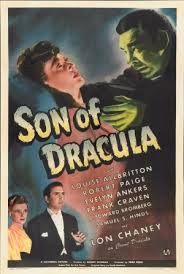
SON OF DRACULA
US, 1943, 80 minutes, Black and white.
Lon Chaney Jr, Louise Allbritton, Robert Paige, Samuel S. Hinds, Evelyn Ankers, Frank Craven, J. Edward Bromberg.
Directed by Robert Siodmak.
Son of Dracula is one of the many enjoyable horror features produced at Universal Studios in the '40s. It bears practically no relation to Universal's original Dracula. However, it is a variation on the theme, with Dracula disguising himself as Count Alucard and coming to the U.S. for fresh blood. Lon Chaney does a more dignified performance as Count Alucard. The rest is B-budget Universal material, stars and sets, but nevertheless coming together quite effectively. The director is Robert Siodmak (Spiral Staircase) who made a number of effective thrillers. An interesting variation on the theme.
1. Interesting and enjoyable horror movie of the '40s? The Dracula tradition?
2. B-budget, studio locations, the atmosphere of the south? Musical score and atmosphere?
3. The title, Count Alucard and his relationship to Dracula? Explanation of the Dracula traditions and the devastation of Transylvania?
4. The focus on the American southern town: the wealthy family and their welcoming Count Alucard, the dance, the death of-the father, the role of the judge, of the doctor? Kay and Claire and their position in society? Frank and his engagement to Claire? The anticipation of the arrival of the Count?
5. Count Alucard and Lon Chaney's style, in the Dracula tradition, the smoke, the bat and the special effects? His arrival, entering the house, killing the father? His relationship with Kay? Pursuing Frank? His attacking the young boy? The confrontation with the doctor? The final confrontation and his death?
6. Kay and her infatuation with the occult, inviting Count Alucard? Breaking the relationship with Frank? Being possessed by Alucard, hiding the coffin in the swamp? The wedding? The confrontation with the doctor? Frank and her visiting him in prison? His killing her?
7. Frank as hero, love for Kay, puzzle, the shooting of the Count, giving himself up, Kay's visit in prison, the attacks, his going to the house, destroying the vampires?
8. The doctor and his interest, concern, phoning the professor, searching the house, confrontation with Alucard and Kay, with Frank, retracing the steps? The professor and his background on vampires?
9. Claire and her concern, the reading of the will, worry about Frank and Kay?
10. Popular characters for this kind of small-budget horror film? Situations, horror atmosphere? The background of the Living Dead and the devastation of Europe? The Undead as a symbol of evil?
Published in Movie Reviews
Published in
Movie Reviews
Tagged under
Saturday, 18 September 2021 19:25
Song to Remember, A
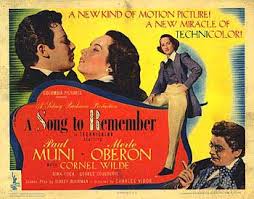
A SONG TO REMEMBER
US, 1945, 113 minutes, Colour.
Cornel Wilde, Merle Oberon, Paul Muni, Stephen Bekassy, Nina Foch, George Colouris, Sig Arno, Howard Freeman, George Macready.
Directed by Charles Vidor.
A Sone, to Remember was a very popular film of 1945 - at the box office and with Oscar nominations. It is a popular biography of Chopin, very popular, the type of potted biography that became popular in succeeding decades. However, it gives some outline of Chopin's life and career, highlights sone of the characters in his life and, of course, gives an opportunity for a great deal of his music to be played.
Cornel Wilde was emerging as a popular star at this time and reached a peak of popularity as Chopin. Paul Muni gives an exaggerated performance as Chopin's music teacher. Merle Oberon is suitably glamorous as Georges Sand. The film
looks lush and the music carries it. It was directed by Charles Vidor (Gilda, The Loves of Carmen). Liszt makes an appearance in this film. Vidor's last film was a biography of Liszt with Dirk Bogarde, Song without End.
1. Popular biography? The outline of Chopin's life? Characters? His music? The pattern of film biographies on a popular level?
2. Colour photography, the re-creation of the 19th century, costumes and decor? Oscar nominations and wins?
3. The importance of the music, the score and its insertion into the biography?
4. The biographical treatment of Chopin, the sketch, the lush '40s treatment? Understanding Chopin as a character? The influences on his music? His career? His Polish background? France?
5. The sketch of Chopin as a boy, life in Poland, his relationship with his parents, their neediness, his teacher, his being pushed? The child prodigy? His own compositions?
6. The young Chopin, Polish nationalism, the revolution and his involvement, meetings, the dire results with the Russians and the executions, the focus on him playing the piano for the Russians and the tracking back to reveal his was accompanying their meal? His parents and the professor outside? His arrogant stances against the Russians? His having to leave the country?
7. His life in Paris, being pushed by the professor, the encounter with the music-seller, Liszt and the duet, the build-up to his concert, the news about Poland and his failure, the professor's conversation with the music critic, Liszt and Georges Sand and their friendship, the arrangement for him to play in the dark? His success and the collage of his success, the great number of compositions? His infatuation with Georges Sand? Going to Majorca, the relationship and its decline, his compositions, his achievement, death?
8. The professor and Paul Muni's ham-fisted performance? Eccentric? His interest in Chopin, his coaching him, the comments on his composition, with the music-seller, with the critics, the concerts? His anguish about his relationship with Georges Sand? The letters home?
9. The sketch of his parents, the family, friends? Their visits to Paris? His break with them?
10. Liszt and his achievement, reputation in Paris, promoting Chopin?
11. Georges Sand and her reputation, novelist, her dress, manner, helping him, the concert, the relationship, Majorca? The failure of their relationship?
12. The sketch of the music critics and their influence?
13. An insight into music composition in Europe in the 19th century? Composition and performance?
Published in Movie Reviews
Published in
Movie Reviews
Tagged under
Saturday, 18 September 2021 19:25
Something About Amelia
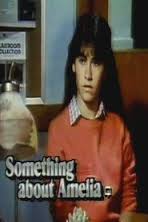
SOMETHING ABOUT AMELIA
US, 1984, 100 minutes, Colour.
Glenn Close, Ted Danson, Roxana Zal, Olivia Cole, Lane Smith, Jane Kazmareck.
Directed by Randa Haines.
Something About Amelia is a powerful and moving telemovie. Set in an average American family, the theme of the telemovie is incest. The film dramatises a situation, highlights the effect on each member of the family and opts at the end, with a hopeful note, for a therapeutic solution to the problem.
The film is particularly well-acted, which makes for its being very convincing. Ted Danson, star of many films including Body Heat and of the television series Cheers, is an interesting choice for the father. The point is made that respectable-seeming parents are responsible for incestuous situations. Glenn Close (Oscar nominee for The World According to Garp, The Big Chill, The Natural) is excellent as the mother and young Roxana Xal does a very good job as Amelia.
The film is designed for home viewing - it makes the subject being treated accessible for a wide-ranging audience. It has the potential for doing a lot of good in raising community consciousness to such problems.
1. An interesting telemovie? Impact? Dramatising of situations? Message? Therapy solution?
2. The American setting: home, work, school, family activities, court, therapy sessions.
3. The straightforward style, the echoes of domestic dramas and comedies, the focus on the characters with close-ups, reactions and responses? The intercutting of the experiences of each member of the family for effect? Atmospheric score?
4. The themes for telemovie and home audience: the reality of incest, statistics, explanations? Themes of need for love, power, affection? The responsibility of the parent? The spouse? The children? The effect on each? The dramatic aspects of the theme? Possibilities for hope and healing?
5. The credits sequences and the establishing of the family, the relationships, the children growing up? The tension in the marriage between Steven and Gail? The girls and their day-by-day situations? The build-up to Amelia's going to the dance? The puzzle about the tensions? The expectations of what was to happen?
6. The fact of Steven having a relationship with his daughter, the appearances being against this, Amelia's declaration and its impact, the variety of reactions, accusations of lies? Coming to terms with the reality? The explanations of behaviour? The effect on Steven? His coming to tell the truth? The scenes of him being by himself - and the irony of the Shirley Temple song and dance routine about 'Daddy Take a Bow'? The resolution with Gail, with Dr Farley, with Amelia? Participation in therapy?
7. The portrait of Amelia: 13, going to the dance, her tensions, the seeming distance with her father, his visiting her room and apologising, his attack on Robert, Robert wanting to take her to the movies, her mother taking sides? Her general unhappiness? The school counsellor seeing this? Giving her the opportunity to talk? Her mother's reaction and accusing her of lying? The coming of the police? The consequences of her declaration?
8. The effect on Amelia, talking to the police, to the counsellor - explaining the situations, the reasons, the effect? Audiences realising she was only a child and her father taking advantage of her? The Centre and the other girls? Return home, Beth's anger - and then later response of love? Her mother realising the truth and the reconciliation? The sessions with Dr Farley? Her father's apology and asking her not to blame herself? Their reconciliation? The impact on a young girl of this experience, the father urging her to silence, her feeling it was the only way to have her father's love and favour?
9. Steven as an ordinary man, relationship with his wife, the reasons for the seduction of his daughter, the lies, the -clash, his reaction to the news, coping, the lawyer, moving out of the house, the clash with Gail and the declaration of hatred, meeting her in the diner, the sessions with Dr Farley, his Amelia enough to apologise and affirm her?
10. Gail as the competent wife and mother,- home, clashes, her reactions to Amelia, her violent reaction to the teacher, the gradual realisation of the truth, reconciliation, telling Beth the truth? Her hatred for Steven? Meeting him, talking about their friends and divorce? Her not divorcing him? The sessions with Dr Farley - and her realisation of her contribution to Steven's alienation and going to their daughter?
11. Beth and the possibilities of repetition, young girl, her relationship with Amelia, her reaction to being bustled out of the house, being told the truth, her hurt reaction, dislike of her father, reconciliation?
12. The sketch of the sympathetic counsellor, the police, the counsellor at the Centre and her ability to get Amelia to talk about her experiences?
13. Dr Farley, his handling each member of the family, the group therapy?
14. The hopes of therapy with truth and love? Insights via emotional response, via the dramatising of situations?
Published in Movie Reviews
Published in
Movie Reviews
Tagged under
Saturday, 18 September 2021 19:25
Someone to Watch Over Me

SOMEONE TO WATCH OVER ME
US, 1987, 106 minutes, Colour.
Tom Berenger, Mimi Rogers, Lorrane Bracco, Andreas Kautselas, Jerry Orbach, John Rubenstein.
Directed by Ridley Scott.
Someone to Watch Over Me is quite a good thriller. It was overshadowed on release by Fatal Attraction, somewhat similar in style and plot. The title comes from the Ira and George Gershwin song which is sung by various artists throughout the film including Sting and Roberta Flack.
Mimi Rogers is a woman who witnesses a murder and has to have police protection for witnessing to the crime. Tom Berenger is very good as the lower class policeman caught up in the world of the wealthy, infatuated with the heroine. Lorraine Bracco is also very good as his wife. While the film focuses on the crime and the menace to the heroine, it also explores the hero and his tangled relationships.
The film is stylish, coming from Ridley Scott who specialised in commercials as well as directing The Duellists, Alien, Blade Runner, Legend.
1. An interesting and enjoyable thriller with style?
2. The familiar B-budget plot given A-budget treatment? Perennial and popular material?
3. The work of Ridley Scott, the photography of New York, making it a character in the film? The glossy world of affluence and class? The contrast with Brooklyn and Queens and the ordinary city? The work of the police? The stars and their strengths?
4. The song and the title, its use, theme?
5. The party and the introduction to the characters? The police, detectives? Boisterous? Relationships? Tom and his relationship with Claire? The ordinary life that they led? The changing situation with his going onto his first case? Woken up in the night? A new beginning?
6. The contrast with the uptown party and its style, people, Claire and Neil and their relationship? Wealthy businessmen? The victim and his relationship with Claire? Her going down to the basement? The confrontation between the businessman and his killer? His death? Claire witnessing, escaping?
7. Claire and her having to be guarded as a witness? Neil and his anger add hard line? The situation, her fear, the vigils, the police? Tom and his care for her? Her taking him in charge, the shopping, the team? Going to the party, her going to the toilet, the confrontation with the killer? The need for tighter protection? The screenplay's suggestion of the interaction between Claire and Tom, their being thrown together, the discovery of the truth? The relationship? The night and the killer's entry? Neil's arrival and anger? The police and having to cope with Tom and the deaths? The separation, Claire willing to act as a decoy? The breaking of the relationship with Tom? The ending?
8. The portrait of Tom, at work, his class, clothes, family, the games with children? Life in Queens? Looking over the new house? Relationship with his wife, love, tensions? His work, surveillance, his clothes, going into society, the contrast with home? Thrown together with Claire? His wife and her threats? The relationship, the night together, the killers and Tom confronting them? The wife and her breaking, leaving home? Contact with his son, phone calls? Discussions with Claire, the break-up? The finale, Claire as decoy, the courage of his wife? The credibility of the reconciliation?
9. The wife and her background in the police, her father, tough, language, the house? Her suspicions, reaction to Tom's comments about swearing? The dinner and the breaking up? The truth? Leaving? Demanding that he come back 'to me'? The build-up to the finale?
10. The police, friendships, the police wives, their work, detection, surveillance? The vigil by Tom's friend? His death?
11. The killer: in himself, power and wealth, the law, giving himself up, released on a technicality? The jogger and his being killed and the assassin taking his place? Death? The build-up to the final confrontation?
12. The thriller themes and their familiarity? The threatened woman, the detective and surveillance, the deaths of the police, the brutal killer The contrast with the themes of relationships, class, love, fidelity and infidelity, break and reconciliation?
Published in Movie Reviews
Published in
Movie Reviews
Tagged under
Saturday, 18 September 2021 19:25
Some Kind of Wonderful
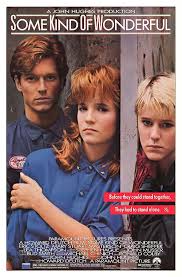
SOME KIND OF WONDERFUL
US, 1987, 95 minutes, Colour.
Eric Stoltz, Leah Thompson, Mary Stuart Masterson, Craig Sheffer, Elias Koteas.
Directed by Howard Deutch.
Some Kind of Wonderful is a very attractive youth film written by John Hughes. In fact, it is a variation on his screenplay for Pretty in Pink. Hughes also wrote Sixteen Candles, The Breakfast Club, Fresh Horses - as well as a number of the National Lampoon comedies and Mr Mon. The film was directed by his associate Howard Deutsch, who also directed Pretty in Pink and The Great Outdoors, written by Hughes.
Erie Stoltz (Mask, Fly 2) is an attractive hero, a quiet artist attracted towards Leah Thompson, a girl from a poor family but who likes to mix with the wealthy. His best friend is the tomboy, played very effectively by Mary Stuart Masterson. (Stoltz plays the Molly Ringwald part of Pretty in Pink, Leah Thompson the Andrew McCarthy? part, Mary Stuart Masterson the Jon Crier part.)
The film shows families, adolescents, love and infatuation, careers, education. It is quite genial, and positive.
1. Attractive youth film? Youth hopes, relationships, pain and difficulties?
2. The town setting, families and homes, the school, jobs?
3. The musical score, the drums and the opening, the range of songs, Miss Amanda Jones?
4. The title and its references?
5. The interaction of the four central characters, introduced during the credits, issues?
6. The portrait of Keith: working in the garage, his father wanting him to go to college, searching all the papers for information? His privacy in his room, Laura invading it, the clash between brother and sister? His art and his skill? The meals and the family talk? His friendship with Watts? Sharing everything with her? Seeing Amanda and Hardy together, attracted towards her, talking with Watts? Arranging detention to be with her, and meeting Duncan and the boys - but sharing the art, Duncan carving, Keith drawing, a friendship? Rescuing Amanda from Hardy? Watts's advice? Asking for the date, Laura and the table talk, her overbearing Hardy talking and planning to fight Keith? Hardy coming to Keith and inviting him? The meetings with Amanda, proposing the date, offering her a lift home - and the car not working? His decision to take out his college money and buy the earrings? Knowing what was in store at the party but facing it? Getting dressed for the party? The clash with his father about the money, assertive - how appropriately? The date, Watts as chauffeur, enjoying the meal, going into the gallery with Duncan's help. the portrait of Amanda? The bowl and the gift of the earrings? Their argument, each using the other, the decision to go to Hardy's party, the confrontation, winning? Amanda returning the earrings, Keith realising his love for Watts? Portrait of a shy type, his feeling out of place with others, his not wanting to go to college, his future?
7. Watts as tomboy, hanging around the garage with Keith, playing her drums, no home life? Her love for Keith and his not realising it? Duncan and his calling her a lesbian? Her giving advice to Keith? At school, lending Keith the car? The talk with Ray and his liking her, her using him to make Keith jealous? Helping Keith buy the earrings? offering to be the chauffeur at the date, her reactions at the various stops, her dislike of Amanda, watching her, apologising? The happy ending?
8. Amanda, popular, her rich friends, glamour? Object of Keith's attentions? Hardy's girl yet his macho using of her? In public, at the service station? Keith rescuing her? Her acceptance of the date, talking with Shane? The lift home? The opportunities to call it off? Hardy's plan? Getting dressed, going out, Watts as chauffeur, her response to the meal, the portrait, the bowl and the gift of the earrings? Her reaction to Keith's talk about the plan, each using the other, her anger, the reconciliation? Going to the party, the confrontation with Hardy, slapping him? Giving Keith the earrings? Her confession about her background, wanting to be popular, being snubbed by the girls, her shame? Keith transforming her?
9. Hardy, the rich boy in school, using Amanda as an object, hurt by her breaking with him, acting tough, his rich friends? Threatening Amanda and Keith? The party, his throwing his weight around, Duncan's arrival and his backing down, humiliation, slapped?
10. Amanda's girlfriends, sharing interests, dropping her and snubbing her? Their talk about wealth, holidays, etc?
11. Keith's sisters, the youngest one with her concern about diet? Laura and her taunting him, with her friends at the restaurant, overhearing Hardy's plans? The reconciliation with Keith?
12. Duncan, his appearance, fighting, fighting, detention, art, his father and the museum, at the party with his friends, confronting Hardy?
13. The parents, the father and his concern about college, discussions at table, argument about the bank money, his going to school to discuss Keith's future, his reaction to Keith's art? His mother's support?
14. A film of families, youth, relationships? Strong values?
Published in Movie Reviews
Published in
Movie Reviews
Tagged under
Saturday, 18 September 2021 19:25
Soliti Ignoti, I/ Big Deal on Madonna Street, Persons Unknown
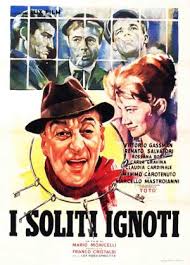
I SOLITI IGNOT1 (BIG DEAL ON MADONNA STREET, PERSONS UNKNOWN)
Italy, 1957, 106 minutes, Black and white.
Vittorio Gassman, Marcello Mastroianni, Toto, Claudia Cardinale, Carla Gravina, Renato Salvatori.
Directed by Mario Monicelli.
I Soliti Ignoti (Big Deal on Madonna Street, Persons Unknown) is a classic Italian comedy of the '50s. It was co-written and directed by Mario Monicelli, director of many comedies from Italy during the '50s and '60s. The film was remade in the United States by Louis Malle as Crackers. Bob Fosse brought it to the Broadway stage as a musical, Big Deal, in the mid'80s.
The film has an enjoyable gallery of eccentric characters portrayed by some of the stars of Italian cinema over several decades: Vittorio Gassman, Marcello Mastroianni. The comedian Toto has a good role. The young Claudia Cardinale also appears.
The film is a parody of the meticulously planned robbery film, especially Jules Dassin's Rififi. The film gets its enjoyment from the nature of the characters, the details of the plans, the eccentric ways in which they go wrong. The film also has a wide range of Italians represented, from north to south - with their own styles, background and slang.
While the style is somewhat dated, the basic comedy is still very appealing and the parody clever.
It was remade as Crackers by Louis Malle and the Russo Brothers used it as the basis for Welcome to Colinwood.
1. An enjoyable comedy? Italian comedy? The status of the film as a classic comedy?
2. The atmosphere of the streets, prisons, homes, apartments? Authentic outdoor location photography? The range of characters? The musical score?
3. The title and its reference to newspaper articles about robberies? The person or persons unknown as the causes of crime? The humorous filling in for the audience to make such unknown persons known?
4. The popularity of the robbery film? The suspense of the tightly planned and executed robbery genre? The film spoofing such genre? The film using the contentions for satire?
5. The focus on Cosimo, the leader of the gang, their lack of success, the car theft, his plans for the big robbery? His going to jail? His trying to trick Peppe into taking his place? The irony of both going to jail? Peppe tricking Cosimo about the details of the robbery? The pathos of Cosimo's being set free in the amnesty, the attempted robbery, his death? The serious side of the spoof?
6. The composition of the gang, their backgrounds, getting together, the bonds between them, their dependence on each other, the plans, the discussions, the fallings out? Tensions? The build-up to the operation? Cosimo’s death? The final details. equipment? The going over of the plan? The execution of the plan - suspense, atmosphere? Things going wrong, the locked doors, the creeping over the roof, the lovers in the flat, the lack of the map, the drilling of the wall? The fiasco with their drilling into the kitchen - and their consoling themselves with the pasta in the refrigerator? Going home to begin another day's work? The humour of the close-up on the newspaper item?
7. Peppe and Vittorio Gassman acting against image in the '50s? His role as a boxer, his part in the scheme, standing in for Cosimo, going to jail? His shrewdness in getting the plans from Cosimo? His determination to carry out the plan himself? His recruiting the gang? His relationship with them? The planning? Everything going wrong? Wandering away at the end - nothing lost, nothing gained?
8. Tiberio and his timidity, his work as a photographer, his presence in the group, hesitations? His mix-up with the free camera? His breaking his arm?
9. Mario as the drifter, his participation in the plan, his meeting of Carmelita, the courting of Carmelita, the tricks to get inside, eluding her brother, the confrontation with her brother?
10. The Sicilian and his strict styles, his hold over his sister, his suspicions? The comic exaggerations of the Sicilian protecting the women? His participation in the plot?
11. Carmelita as the younger sister, being subdued by her brother, attracted towards Mario, their falling in love, the devices of getting him into the house, of getting him out of the house?
12. Dante the veteran safecracker, his being approached by the gang, his pompous lectures on safecracking, participation in the plot?
13. Nicoletta and her relationship, participation in the group?
14. An enjoyable spoof rogues' gallery?
Published in Movie Reviews
Published in
Movie Reviews
Tagged under
Saturday, 18 September 2021 19:25
Sleeping Beauty
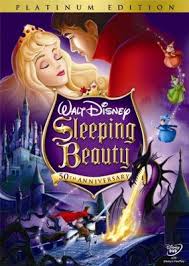
SLEEPING BEAUTY
US, 1958, 75 minutes, Colour.
Directed by Clyde Geronomi.
Sleeping Beauty is considered the Walt Disney Studios most ambitious animation feature. Though prepared in the early '50s in the aftermath of the success of Cinderella and Alice in Wonderland, it was not completed till 1959. By then, wide screen processes had become popular and this film was made in Technirama.
It is lavish, designed for the wide screen and most impressive in its detail. The story, based on the popular Charles Perrault version of Sleeping Beauty, is familiar fairytale material. Disney Studios provided some variations on the theme, most particularly in the three good fairies.
The basic plot of the princess, the prince waking her from sleep, the wicked fairy and witch are all familiar. However, there is pageantry in the opening, forest delight in the middle, and extraordinary battle in which Maleficent
the witch transforms herself into a dragon and does battle with Prince Philip.
As with most Disney animation films, there is a musical score and a range of songs: 'Once Upon a Dream', 'Hail the Princess Aurora,' 'I Wonder', 'The Skump Song' (for the two rival kings), 'The Sleeping Beauty Song'.
The film is interesting to watch in retrospect - in comparison with other Disney animation features rather in the economic questions of film-making of the time and in the light of interest by psychologists in fairy tales. Sleeping Beauty is a delight for family audiences - and a good source for psychological discussion.
1. The impact of this Disney film? In its time? Ambitions? Later?
2. The use of wide screen processes and design, pageantry and beauty? Action? The musical score and the songs for the mood and characters?
3. The familiarity of the story: the fairy tale, popular, myth? Impact for children? Adults? The Disney style: serious, humorous, cute? The comedy, the songs?
4. The familiar material and the variations? The hero and heroine? Maleficent? The magic of the three good fairies? The confrontation between good and evil?
5. The opening with the royalty, the pageantry, the king and queen, the princess, the joy? The absence of the bad fairy? The presence of the good fairies? The spell and the three good fairies protecting Aurora?
6. Aurora as heroine, beauty, in the forest, not knowing her identity? The encounter with Prince Philip, falling in love? The spell, her sleep? Rescued?
7. Philip as hero, in the forest, his love, the kidnapping and imprisonment, the fighting with the dragon? His waking the princess? The comedy with his horse Sampson?
8. The good fairies: the three, their look, manner, pleasant old women, humour, the magic and the making of the dress, the conflict between pink and blue, the chases and rescues?
9. Maleficent in the Disney tradition of witches? Vision and prophecy? The crows, her goons and their sounds, look and work? Her vanity, malice towards Aurora? The spell, her disguises, instilling fear? her confrontation with Philip? Turning into the dragon, the fight and her death?
10. The presentation of the two kings and their rivalry, humour, song? The spoof on royalty?
11. The evil symbols, the crow and the statue, the goons, the dragon and the fight? Good versus evil?
12. The various versions of Sleeping Beauty? Disney's taking its place amongst them? A classic? The echo of Tchaikovsky’s ballet in the adaptation of the musical score?
Published in Movie Reviews
Published in
Movie Reviews
Tagged under
Saturday, 18 September 2021 19:25
Stowaway
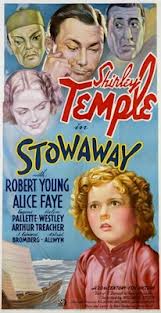
STOWAWAY
US, 1936, 86 minutes, Black and white.
Shirley Temple, Robert Young, Alice Faye, Eugene Pallette, Helen Westley, Arthur Treacher, J. Edward Bromberg.
Directed by William A. Seiter.
Stowaway is one of the many pleasant Shirley Temple vehicles of the mid-'30s. Within two years Shirley Temple had topped box office popularity in the United States in the atmosphere of the Depression. She was making up to four films a year in the 1935-38 period from which this film comes. The films generally have the same kind of formula - the touch of the contemporary fairy tale, no matter what their setting.
This film opens in the popular China of '30s movies - with missionaries and warlord and violence. There is also the modern Shanghai and the romantic cruise of the Orient. Shirley is an orphan in China - speaking Chinese fluently amongst her other talents. These include, of course, a talent for singing and dancing. In this case it also means that she can sing a song in the style of A1 Jolson, of Eddie Cantor and dance it like Fred Astaire and Ginger Rogers. She is certainly a forward and precocious child.
In support she has the debonair Robert Young and the charming Alice Faye (who had appeared with her in Poor Little Rich Girl). Helen Westley enjoys herself as an intrusive mother-in-law and Arthur Treacher is the discreet English butler. Definitely for Shirley fans - as well as for adults. But it is very much a vehicle of the '30s.
1. Entertainment value as a comedy of the 1930s? Romance? Shirley Temple vehicle? The popularity of Shirley Temple's character and, style for Depression audiences? Later?
2. Black and white photography, the studio's version of China and Shanghai, eastern ports? Song and dance routines? Comic touches? The musical scores and the romantic and humorous songs? Cute Shirley Temple style, ballad Alice Faye, style?
3. The title and expectations? The indication of shipboard comedy and romance?
4. The opening in China, the stubborn missionary, Barbara as an orphan, her living in China and having a Chinese name, fluent in Chinese? Her being saved by the Chinese - who bequeathed her his proverbs? Her trip to Shanghai? With her dog, hungry? Helping Tommy Randall with h is buying? The outing with him? Asleep in his car? Put on board the ship?
5. Ching-Ching? - cute Shirley Temple character, Tommy Randall's comment that she looked like a child but sounded like an adult? Her love for the Chinese? Her boldness on the boat? The Captain allowing her to stay? Tommy looking after her? Susan's concern for her? Mrs Hope's dislike of her? The shipboard activities, including the valet trying to play? The problems of a child from China, her having to go to an institution? Her being rescued by Tommy and Susan marrying? The build-up to the divorce - and the discussion with the judge, being coached what to say by the judge? The happy ending?
6. Robert Young's style as the typical debonair type of 1930s movies - wealthy, away from parents, women chasing him? Self-confidence, drinking, drinking friends, his valet? His irresponsibility as regards Barbara? His discovery of her, his apology, looking after her, the outing in Hong Kong? His attraction towards Susan, her rejection? His proposal to save Barbara? The divorce - but, of course, the happy ending?
7. Alice Faye's style as Susan, under Mrs Hope's thumb, her self-assertion, not in love with Richard, attracted towards Tommy but rejecting him, concern for Ching-Ching? Going through the marriage ceremony? Being compromised in Mrs Hope's eyes, Richard's proposal, the divorce - but declaring her love for Tommy?
8. The comedy with Mrs Hope as the interfering mother-in-law? Richard as the typical colonial type out in the East - trying to preserve American style and values in Bangkok? His being under the thumb of his mother-in-law?
9. The gallery of minor characters - the Captain and his concern, the valet and his very English style, but imitating trains etc. to amuse Ching-Ching? Tommy's extravagant friends? The judge and his concern?
10. The musical interludes - Alice Faye's romantic style? Shirley Temple's cute imitations of Al Jolson, Eddie Cantor, Pred Astaire and Ginger Rogers?
11. The impact of this kind of film during the Depression? Dreams come true? Alice Faye's dialogue criticising the debonair hero as a time-waster and as a museum piece? The film in its time, In retrospect?
Published in Movie Reviews
Published in
Movie Reviews
Tagged under
Saturday, 18 September 2021 19:25
Story of Louis Pasteur, The

THE STORY OF LOUIS PASTEUR
US, 1935, 85 minutes, Black and white.
Paul Muni, Josephine Hutchinson, Anita Louise, Donald Woods, Fritz Leiber, Henry O'Neill, Porter Hall, Akim Tamiroff.
Directed by William Dieterle.
The Story of Louis Pasteur is one of several biographies made by Warner Bros and directed by William Dieterle. Dieterle also directed Paul Muni in The Story of Emile Zola and made films like Juarez and A Dispatch from Reuters.
Paul Muni won the Oscar for Best Actor of 1936. He plays Pasteur as a crotchety genius. The film gives us a glimpse of 19th century questions about scientific advancement, experimentation, suspicions and confrontations of medical pioneers. The running time of the film is brief but is quite effective in reminding us of what Pasteur contributed to modern health.
1. Interesting biopic? Information about Pasteur? Tribute to him?
2. The quality of the film, Oscar nominations, Paul Muni's Oscar-winning performance?
3. Warner Bros. production values, the contribution of William Dieterle? Black and white photography? Musical score?
4. France in the 19th century, evocation of Paris, the world of medicine, academia? The French countryside?
5. The portrait of Pasteur in his time: as a man, family, French, his work, insights, experiments, theories, society, the attacks and his vindication?
6. The world of medicine and hygiene, cleanliness and lack of cleanliness, the death toll through carelessness and lack of cleanliness, the discovery of microbes and germs? Theories, the use of the microscope, experiments? The questions of anthrax and the testing of cattle, injections, vaccinations?
7. The medical fraternity and their reaction to Pasteur? The dramatic opening sequence of the husband who shot the careless doctor who killed his wife? Dr Charbonnet and his advice to the Emperor? The rivals to Pasteur? His friends? John and his interests, his marrying Pasteur's daughter? Lord Lister coming for the anthrax experiments, the final acclaim?
8. Medical progress, public opinion, public experiments, the reporters? The incident of the anthrax tests, the planning of it, the public interest, doctors and their rivalries, jealousies of Pasteur? His self-confidence? The sheep seeming to be dead - and then getting up?
9. Pasteur and his care of humans, their illnesses, his care, vaccinations? The German doctor, the German patients and his help? Even though he had a stroke? The sketch of his family life, the support of his wife, John?
11. The personal side of Pasteur - a blend of the irascible and the genius?
12. The tribute to Pasteur? History repeating itself in its treatment of those who break through like Pasteur?
Published in Movie Reviews
Published in
Movie Reviews
Tagged under
Saturday, 18 September 2021 19:25
Stopover Tokyo
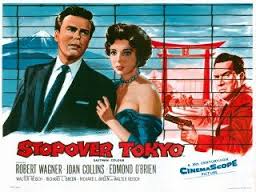
STOPOVER TOKYO
US, 1957, 100 minutes, Colour.
Robert Wagner, Joan Collins, Edmond O'Brien, Ken Scott,
Larry Keating.
Directed by Richard L. Breen.
Stopover Tokyo is a colourful action thriller using Japanese locations. Robert Wagner is adept at this kind of hero. A young and attractive Joan Collins is the heroine. Edmond O'Brien has no trouble as the villain. The film is based on a novel by J. P. Marquand. Familiar material of its kind - entertainingly done.
1. The popularity of this kind of colourful espionage thriller? A film of the 1950s?
2. Japanese location photography, colour? The travelogue touch? Action sequences? Musical score?
3. The focus on Japan? Counter-espionage work? Communist plots? Politics, High Commissioners? Bombings? The familiar material of espionage and counter-espionage?
4. Robert Wagner's style as Mark Fannon? Arrival in Tokyo, his cover, the encounter with Tina, her help? The search for information about George Underwood? The contact with Nobika? Tony Barrett? The attempts on Mark's life? Nobika's being shot? The messages? The search for documents? Explosives? The attitude of the High Commissioner?. The dedication of the peace memorial? Tony's help? the booby trap? Tina and her not going with Mark? The loner American hero?
5. Underwood and his contacts with the Communists, the plan to blow up the peace memorial? The death of the High Commissioner? The contacts with Mark? Suave style? Brutality? The shooting of Nobika? Of Tony? The counteracting of the plot?
6. Tina and her work in Tokyo, Tony Barrett? Friendship with Mark? Helping him to get information? her discovering the truth about both being agents? Glamorous heroine?
7. The High Commissioner, his attitude towards the plot, his going to the dedication of the peace memorial?
8. The Japanese agents? Contacts?
9. The picture of Communist activities at the time? American involvement? Japanese experiences in the decade after the war? A thriller of its time?
Published in Movie Reviews
Published in
Movie Reviews
Tagged under